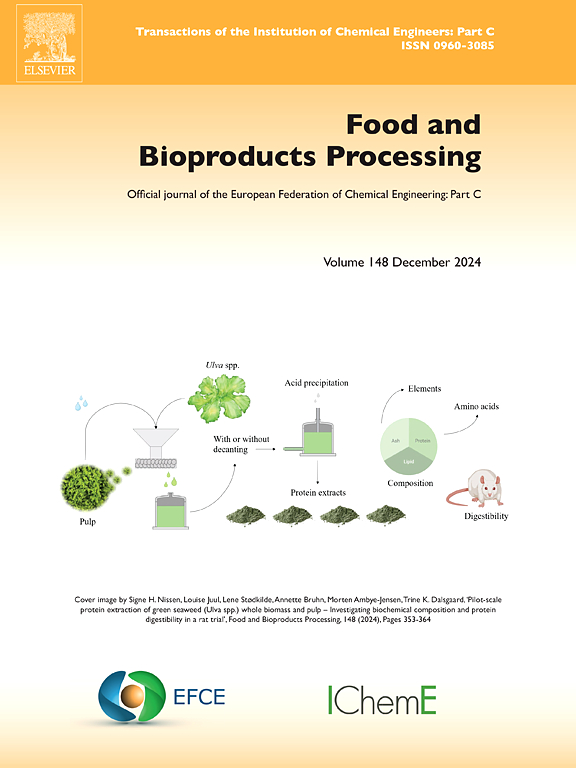通过基于物理的数字水果双胞胎,确定跨大陆柑橘供应链中的权衡取舍,以及由此产生的利益相关者的激励冲突
IF 3.4
2区 农林科学
Q2 BIOTECHNOLOGY & APPLIED MICROBIOLOGY
引用次数: 0
摘要
采收后供应链经常面临着最大限度地提高水果质量和采收后寿命、最大限度地减少食物损失和最大限度地减少冷藏运输过程中能源消耗的冲突要求。例如,通常遇到的权衡是在货物中保持零度以下的温度,以杀死水果害虫的幼虫,同时避免对水果造成冷害。在这种情况下,“什么水果属性最重要,对谁最重要”的问题就出现了。供应链涉及多个利益相关者,包括种植者、出口商、监管机构、分销商、零售商,最后是消费者。每个涉众都有不同的目标要满足,因此,前面提到的权衡以不同的方式进行评估。因此,这种情况经常引起冷链运输决策的相互矛盾的激励。目的在本研究中,我们确定了呼吸驱动的剩余质量、蒸腾驱动的水分损失、果蝇死亡率、冷害发生率、冷凝风险以及运输过程中消耗的能量对环境的影响之间的矛盾权衡。为此,我们在冷藏容器中开发了基于物理的柑橘类水果数字双胞胎。数字孪生利用商业运输中测量的交货空气温度作为输入。此外,它还采用机械模拟来模拟装运中的湿热和生理水果行为。我们使用了来自这个数字孪生体的可操作指标,并将其转换为可取性函数,该函数评估指标组合满足各自涉众定义的目标的程度。通过这种方法,我们绘制了不同运输方案在多大程度上满足柑橘出口供应链中关键利益相关者的目标,即出口商、监管机构、分销商、零售商和消费者。结果和结论我们的研究结果表明,不同利益相关者的期望曲线随时间的变化存在明显差异。我们发现,在所有利益相关者中,只有监管者的期望曲线在供应链末端保持在令人满意的水平。我们还评估了不同的运输温度场景,并强调了温度权衡如何在不同的度量中表现出来。在这里,我们强调,任何指标都不可能在不影响其他指标的情况下单独优化。我们的研究通过利用数字孪生提供的互补见解,弥合了利益相关者观点定量估计方面的巨大差距。这是让所有相关利益相关者参与设计影响柑橘供应链的最佳实践和政策的关键一步。本文章由计算机程序翻译,如有差异,请以英文原文为准。
Identifying trade-offs in trans-continental citrus supply chains and the resulting conflicting stakeholder's incentives via physics-based, digital fruit twins
Context
Postharvest supply chains are often confronted with conflicting requirements between maximizing fruit quality and postharvest life, minimizing food loss, and minimizing energy consumption during refrigerated transportation. For example, a commonly encountered trade-off is maintaining sub-zero temperatures in a shipment to kill the larvae of fruit pests while avoiding inducing chilling injury in the fruit. In this context, the question of "what fruit attributes matter most, and to whom" comes in. Supply chains involve multiple stakeholders, including growers, exporters, regulators, distributors, retailers, and finally the consumers. Each stakeholder has different targets to meet, and therefore, the aforementioned trade-offs are assessed in different ways. This situation thereby often raises conflicting incentives for decision-making in cold chain transport.
Objective
In this study, we identify the conflicting trade-offs between respiration-driven remaining quality, transpiration-driven moisture loss, mortality of fruit fly, incidence of chilling injury, risk of condensation, and environmental impact due to the energy consumed during shipping.
Methods
To this end, we developed physics-based digital twins of citrus fruit in a refrigerated container. The digital twin utilizes measured delivery air temperature in commercial shipments as an input. In addition, it employs mechanistic simulations to mimic the hygrothermal and physiological fruit behavior in a shipment in-silico. We used the actionable metrics from this digital twin and translated these into desirability functions, which assess how well a combination of metrics satisfies the goals defined by the respective stakeholder. With this approach, we mapped to what extent different shipping scenarios meet the targets of the key stakeholders in the citrus export supply chain, namely exporters, regulators, distributors, retailers, and also consumers.
Results and conclusions
Our findings show clear differences in how the desirability curves evolve over time for different stakeholders. We found that amongst all stakeholders, only the desirability curve of the regulator remains at a satisfactory level at the end of the supply chain. We also evaluated different shipping temperature scenarios and highlighted how the temperature trade-off manifests in different metrics. Here, we highlighted that any metric cannot be optimized in isolation without adversely influencing other metrics.
Significance
Our study bridges a large gap in the quantitative estimation of stakeholder perspectives by leveraging the complementary insights provided by digital twins. This is a key step toward involving all relevant stakeholders to design the best practices and policies influencing the citrus supply chain.
求助全文
通过发布文献求助,成功后即可免费获取论文全文。
去求助
来源期刊

Food and Bioproducts Processing
工程技术-工程:化工
CiteScore
9.70
自引率
4.30%
发文量
115
审稿时长
24 days
期刊介绍:
Official Journal of the European Federation of Chemical Engineering:
Part C
FBP aims to be the principal international journal for publication of high quality, original papers in the branches of engineering and science dedicated to the safe processing of biological products. It is the only journal to exploit the synergy between biotechnology, bioprocessing and food engineering.
Papers showing how research results can be used in engineering design, and accounts of experimental or theoretical research work bringing new perspectives to established principles, highlighting unsolved problems or indicating directions for future research, are particularly welcome. Contributions that deal with new developments in equipment or processes and that can be given quantitative expression are encouraged. The journal is especially interested in papers that extend the boundaries of food and bioproducts processing.
The journal has a strong emphasis on the interface between engineering and food or bioproducts. Papers that are not likely to be published are those:
• Primarily concerned with food formulation
• That use experimental design techniques to obtain response surfaces but gain little insight from them
• That are empirical and ignore established mechanistic models, e.g., empirical drying curves
• That are primarily concerned about sensory evaluation and colour
• Concern the extraction, encapsulation and/or antioxidant activity of a specific biological material without providing insight that could be applied to a similar but different material,
• Containing only chemical analyses of biological materials.
 求助内容:
求助内容: 应助结果提醒方式:
应助结果提醒方式:


